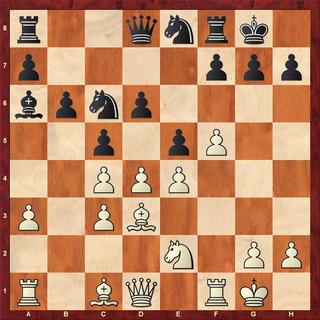Black to Play
Published in Chess Puzzles

[Today, you have a full game to study, especially if you're a Nimzo-Indian player from either side. Two top ten in the world at that time go at it.] Our puzzle is more of a positional question than some mate in four. What would you do for move 13?
Bronstein,David I - Najdorf,Miguel [E29], Candidates Tournament Budapest (5), 1950: 1.d4 Nf6 2.c4 e6 3.Nc3 Bb4 4.a3 Bxc3+ 5.bxc3 c5 6.e3 Nc6 7.Bd3 0–0 8.Ne2 d6 9.e4 [It's at this point Black can play the pawn exchange, then e5 and be OK. However, Ne8 was very popular at the time. The idea is to avoid the pin with Bg5 and be able to play e5 so as to capture on f4 if White plays f4.] 9...Ne8 10.0–0 b6 [There was still time to get e5 in.] 11.f4 Ba6 [Here, f5 by Black was required. Black can't let White get f5 in, and we will see why.] 12.f5 e5 [If Black tries 12...cxd4 13.cxd4 exf5 14.exf5 Na5 15.f6 Nxf6 16.Bg5 Bxc4 17.Bxf6 gxf6 18.Ng3 Bxd3 19.Qxd3 Kh8 White is two pawns down, but will dominate the position after Nf5.] SEE DIAGRAM 13.f6! Kh8 [Black sees that 13...Nxf6 14.d5 Na5 15.Bg5 and the knight gets pinned after all, with serious damage to the kingside pawn structure about to happen. (The defensive key, however, was 14...Ne7 15.Bg5 Ne8 16.Ng3 Bc8 17.Nf5 f6 18.Bd2 Nxf5 19.exf5 where Black can put up a tenacious defense. White still has the edge, though.)] 14.d5 Na5 15.Ng3 gxf6 16.Nf5 Bc8 17.Qh5 Bxf5 18.exf5 Rg8 19.Rf3 Rg7 20.Bh6 Rg8 21.Rh3 1–0 Mate or heavy material loss is coming.
Send questions and comments to PTamburro@aol.com.






